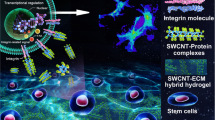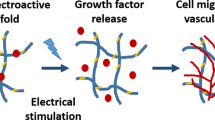Abstract
Purpose
This study was aimed to develop a hydrogel-nanofiber as an advanced carrier for adipose derived human mesenchymal stem cells (AD-MSCs) and evaluate its potential for immunomodulatory therapies applicable to surface coating of drug eluting stent (DES) against coronary artery diseases (CAD).
Methods
A mixture of dispersing-nanofibers (dNFs) and poly (ethylene glycol)-diacrylate (PEGDA) were blended with sodium alginate to achieve robust mechanical strength. The effects of stem cell niche on cell viability and proliferation rates were evaluated using LDH assay and alamar blue assay, respectively. The amount of Nile-red microparticles (NR-MPs) remained in the hydrogel scaffolds was examined as an index for the physical strength of hydrogels. To evaluate the immunomodulatory activity of AD-MSCs as well as their influence by ROS, the level of L-Kynurenine was determined as tryptophan replacement compounds in parallel with IDO secreted from AD-MSCs using a colorimetric assay of L-amino acid.
Results
Both SA-cys-PEG and SA-cys-dNF-PEG upon being coated on stents using electrophoretic deposition technique displayed superior mechanical properties against the perfused flow. d-NFs had a significant impact on the stability of SA-cys-dNF-PEG, as evidenced by the substantial amount of NR-MPs remained in them. An enhanced subcellular level of ROS by spheroidal cluster yielded the high concentrations of L-Kynurenine (1.67 ± 0.6 μM without H2O2, 5.2 ± 1.14 μM with 50 μM of H2O2 and 8.8 ± 0.51 μM with 100 μM of H2O2), supporting the IDO-mediated tryptophan replacement process.
Conclusion
The “mud-and-straw” hydrogels are robust in mechanical property and can serve as an ideal niche for AD-MSCs with immunomodulatory effects.













Similar content being viewed by others
Abbreviations
- d-NFs:
-
Dispersing-nanofibers
- EPD:
-
Electrophoretic deposition
- IDO:
-
Indoleamine 2,3-dioxygenase
- NR-MPs:
-
Nile-red microparticles
- ROS:
-
Reactive oxygen species
- SA-cys:
-
Hydrogel scaffolds made of Cysteine-conjugated sodium alginate
- SA-cys-dNF:
-
Hydrogel scaffolds made of SA-cys blended with dNFs
- SA-cys-dNF-PEG:
-
Hydrogel scaffolds made of SA-cys cross-linked with dNFs and PEG-DA
- SA-cys-PEG:
-
Hydrogel scaffolds made of SA-cys cross-linked with PEG-DA
References
Lusis AJ. Atherosclerosis. Nature. 2000;407:233–41.
Maisel WH. Unanswered questions–drug-eluting stents and the risk of late thrombosis. N Engl J Med. 2007;356:981–4.
Hulsmans M, Van Dooren E, Holvoet P. Mitochondrial reactive oxygen species and risk of atherosclerosis. Curr Atheroscler Rep. 2012;14:264–76.
Oh B, Lee CH. Nanofiber for cardiovascular tissue engineering. Expert Opin Drug Deliv. 2013;10:1565–82.
Oh B, Lee CH. Nanofiber-coated drug eluting stent for the stabilization of mast cells. Pharm Res. 2014;31:2463–78.
Kode JA, Mukherjee S, Joglekar MV, Hardikar AA. Mesenchymal stem cells: immunobiology and role in immunomodulation and tissue regeneration. Cytotherapy. 2009;11:377–91.
Nauta AJ, Fibbe WE. Immunomodulatory properties of mesenchymal stromal cells. Blood. 2007;110:3499–506.
Nakajima H, Uchida K, Guerrero AR, Watanabe S, Sugita D, Takeura N, et al. Transplantation of mesenchymal stem cells promotes an alternative pathway of macrophage activation and functional recovery after spinal cord injury. J Neurotrauma. 2012;29:1614–25.
Jiang XX, Zhang Y, Liu B, Zhang SX, Wu Y, Yu XD, et al. Human mesenchymal stem cells inhibit differentiation and function of monocyte-derived dendritic cells. Blood. 2005;105:4120–6.
Zanotti L, Sarukhan A, Dander E, Castor M, Cibella J, Soldani C, et al. Encapsulated mesenchymal stem cells for in vivo immunomodulation. Leukemia. 2013;27:500–3.
Hsu WT, Lin CH, Chiang BL, Jui HY, Wu KK, Lee CM. Prostaglandin E2 potentiates mesenchymal stem cell-induced IL-10+IFN-gamma+CD4+ regulatory T cells to control transplant arteriosclerosis. J Immunol. 2013;190:2372–80.
Engela AU, Baan CC, Dor FJ, Weimar W, Hoogduijn MJ. On the interactions between mesenchymal stem cells and regulatory T cells for immunomodulation in transplantation. Front Immunol. 2012;3:126.
Chen SL, Zhu CC, Liu YQ, Tang LJ, Yi L, Yu BJ, et al. Mesenchymal stem cells genetically modified with the angiopoietin-1 gene enhanced arteriogenesis in a porcine model of chronic myocardial ischaemia. J Int Med Res. 2009;37:68–78.
Abdi R, Fiorina P, Adra CN, Atkinson M, Sayegh MH. Immunomodulation by mesenchymal stem cells: a potential therapeutic strategy for type 1 diabetes. Diabetes. 2008;57:1759–67.
Yao L, Heuser-Baker J, Herlea-Pana O, Iida R, Wang Q, Zou MH, et al. Bone marrow endothelial progenitors augment atherosclerotic plaque regression in a mouse model of plasma lipid lowering. Stem Cells. 2012;30:2720–31.
De Miguel MP, Fuentes-Julian S, Blazquez-Martinez A, Pascual CY, Aller MA, Arias J, et al. Immunosuppressive properties of mesenchymal stem cells: advances and applications. Curr Mol Med. 2012;12:574–91.
Wang J, Lin L, Cheng Q, Jiang L. A strong bio-inspired layered PNIPAM-Clay nanocomposite hydrogel. Angew Chem Int Ed. 2012;51:4676–80.
Shi X-W, Tsao C-Y, Yang X, Liu Y, Dykstra P, Rubloff GW, et al. Electroaddressing of cell populations by co-deposition with calcium alginate hydrogels. Adv Funct Mater. 2009;19:2074–80.
Kim TG, Park S-H, Chung HJ, Yang D-Y, Park TG. Hierarchically assembled mesenchymal stem cell spheroids using biomimicking nanofilaments and microstructured scaffolds for vascularized adipose tissue engineering. Adv Funct Mater. 2010;20:2303–9.
Wegst UG, Bai H, Saiz E, Tomsia AP, Ritchie RO. Bioinspired structural materials. Nat Mater. 2015;14:23–36.
Jindal AB, Wasnik MN, Nair HA. Synthesis of thiolated alginate and evaluation of mucoadhesiveness, cytotoxicity and release retardant properties. Indian J Pharm Sci. 2010;72:766–74.
Yoo JW, Lee JS, Lee CH. Characterization of nitric oxide-releasing microparticles for the mucosal delivery. J Biomed Mater Res A. 2010;92:1233–43.
Oh B, Lee CH. Advanced cardiovascular stent coated with nanofiber. Mol Pharm. 2013;10:4432–42.
Cui W, Cheng L, Li H, Zhou Y, Zhang Y, Changa J. Preparation of hydrophilic poly(l-lactide) electrospun fibrous scaffolds modified with chitosan for enhanced cell biocompatibility. Polymer. 2012;53:2298–305.
Zhong X, Lu Z, Valtchev P, Wei H, Zreiqat H, Dehghani F. Surface modification of poly(propylene carbonate) by aminolysis and layer-by-layer assembly for enhanced cytocompatibility. Colloids Surf B: Biointerfaces. 2012;93:75–84.
Shinohara S, Kihara T, Sakai S, Matsusaki M, Akashi M, Taya M, et al. Fabrication of in vitro three-dimensional multilayered blood vessel model using human endothelial and smooth muscle cells and high-strength PEG hydrogel. J Biosci Bioeng. 2013;116:231–4.
Ankrum JA, Dastidar RG, Ong JF, Levy O, Karp JM. Performance-enhanced mesenchymal stem cells via intracellular delivery of steroids. Sci Rep. 2014;4:4645.
Ren G, Su J, Zhang L, Zhao X, Ling W, L′Huillie A, et al. Species variation in the mechanisms of mesenchymal stem cell-mediated immunosuppression. Stem Cells. 2009;27:1954–62.
Ma S, Xie N, Li W, Yuan B, Shi Y, Wang Y. Immunobiology of mesenchymal stem cells. Cell Death Differ. 2013;21:216–25.
Francois M, Romieu-Mourez R, Li M, Galipeau J. Human MSC suppression correlates with cytokine induction of indoleamine 2,3-dioxygenase and bystander M2 macrophage differentiation. Mol Ther. 2012;20:187–95.
Braun D, Longman RS, Albert ML. A two-step induction of indoleamine 2,3 dioxygenase (IDO) activity during dendritic-cell maturation. Blood. 2005;106:2375–81.
Roemeling-van Rhijn M, Mensah FK, Korevaar SS, Leijs MJ, van Osch GJ, Ijzermans JN, et al. Effects of hypoxia on the immunomodulatory properties of adipose tissue-derived mesenchymal stem cells. Front Immunol. 2013;4:203.
Liu Y, Wang W, Acharya G, Shim YB, Choi ES, Lee CH. Advanced stent coating for drug delivery and in vivo biocompatibility. J Nanoparticle Res. 2014;15:1–16.
McLaughlin SGA, Szabo G, Eisenman G, Ciani SM. Surface charge and the conductance of phospholipid membranes*. Proc Natl Acad Sci U S A. 1970;67:1268–75.
Schmid T, Messmer A, Yeo BS, Zhang W, Zenobi R. Towards chemical analysis of nanostructures in biofilms II: tip-enhanced Raman spectroscopy of alginates. Anal Bioanal Chem. 2008;391:1907–16.
Read ES, Thompson KL, Armes SP. Synthesis of well-defined primary amine-based homopolymers and block copolymers and their Michael addition reactions with acrylates and acrylamides. Polym Chem. 2010;1:221–30.
Cheng C, Helderman F, Tempel D, Segers D, Hierck B, Poelmann R, et al. Large variations in absolute wall shear stress levels within one species and between species. Atherosclerosis. 2007;195:225–35.
Shrestha S, Irvin MR, Grunfeld C, Arnett DK. HIV, inflammation, and calcium in atherosclerosis. Arterioscler Thromb Vasc Biol. 2014;34:244–50.
Liu J, Chen W, Zhao Z, Xu HH. Reprogramming of mesenchymal stem cells derived from iPSCs seeded on biofunctionalized calcium phosphate scaffold for bone engineering. Biomaterials. 2013;34:7862–72.
Muller P, Bulnheim U, Diener A, Luthen F, Teller M, Klinkenberg ED, et al. Calcium phosphate surfaces promote osteogenic differentiation of mesenchymal stem cells. J Cell Mol Med. 2008;12:281–91.
Laschke MW, Schank TE, Scheuer C, Kleer S, Schuler S, Metzger W, et al. Three-dimensional spheroids of adipose-derived mesenchymal stem cells are potent initiators of blood vessel formation in porous polyurethane scaffolds. Acta Biomater. 2013;9:6876–84.
Huang CC, Chen DY, Wei HJ, Lin KJ, Wu CT, Lee TY, et al. Hypoxia-induced therapeutic neovascularization in a mouse model of an ischemic limb using cell aggregates composed of HUVECs and cbMSCs. Biomaterials. 2013;34:9441–50.
Notara M, Scotchford CA, Grant DM, Weston N, Roberts GA. Cytocompatibility and hemocompatibility of a novel chitosan-alginate gel system. J Biomed Mater Res A. 2009;89:854–64.
Gao W, Lin T, Li T, Yu M, Hu X, Duan D. Sodium alginate/heparin composites on PVC surfaces inhibit the thrombosis and platelet adhesion: applications in cardiac surgery. Int J Clin Exp Med. 2013;6:259–68.
Kamouna EA, Kenawyb ES, Tamerc TM, El-Meligyb MA, Eldina MSM. Poly (vinyl alcohol)-alginate physically crosslinked hydrogel membranes for wound dressing applications: characterization and bio-evaluation. Arab J Chem. 2015;8:38–47.
Alamein MA, Liu Q, Stephens S, Skabo S, Warnke F, Bourke R, et al. Nanospiderwebs: artificial 3D extracellular matrix from nanofibers by novel clinical grade electrospinning for stem cell delivery. Adv Healthcare Mater. 2013;2:702–17.
Doshi N, Swiston AJ, Gilbert JB, Alcaraz ML, Cohen RE, Rubner MF, et al. Cell-based drug delivery devices using phagocytosis-resistant backpacks. Adv Mater. 2011;23:H105–9.
Parisi-Amon A, Mulyasasmita W, Chung C, Heilshorn SC. Protein-engineered injectable hydrogel to improve retention of transplanted adipose-derived stem cells. Adv Healthcare Mater. 2013;2:428–32.
Naito H, Yoshimura M, Mizuno T, Takasawa S, Tojo T, Taniguchi S. The advantages of three-dimensional culture in a collagen hydrogel for stem cell differentiation. J Biomed Mater Res A. 2013;101:2838–45.
Cheng Y, Tsao C-Y, Wu H-C, Luo X, Terrell JL, Betz J, et al. Electroaddressing functionalized polysaccharides as model biofilms for interrogating cell signaling. Adv Funct Mater. 2012;22:519–28.
Yang X, Kim E, Liu Y, Shi X-W, Rubloff GW, Ghodssi R, et al. In-film bioprocessing and immunoanalysis with electroaddressable stimuli-responsive polysaccharides. Adv Funct Mater. 2010;20:1645–52.
ACKNOWLEDGMENTS AND DISCLOSURES
This research was supported in part by funds provided from Graduate Studies Research Grant program, UMKC and Dean’s Bridge Fund program from School of Pharmacy, UMKC.
Author information
Authors and Affiliations
Corresponding author
Rights and permissions
About this article
Cite this article
Oh, B., Melchert, R.B. & Lee, C.H. Biomimicking Robust Hydrogel for the Mesenchymal Stem Cell Carrier. Pharm Res 32, 3213–3227 (2015). https://doi.org/10.1007/s11095-015-1698-y
Received:
Accepted:
Published:
Issue Date:
DOI: https://doi.org/10.1007/s11095-015-1698-y




